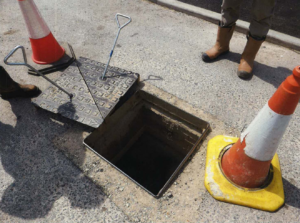Two companies and two people have been sentenced after an 18-year-old construction worker was fatally injured while working on a house-build construction site in Boston, Lincolnshire.
P & R Plant Hire (Lincolnshire) Limited, D. Brown (Building Contractors) Limited, Brent Woods and Darrell Tripp were all fined following the death of Josh Disdel.
(Lincolnshire) Limited, D. Brown (Building Contractors) Limited, Brent Woods and Darrell Tripp were all fined following the death of Josh Disdel.
In July 2018 Mr Disdel, and another worker, both employed by P & R Plant Hire (Lincolnshire) Limited, had been tasked with clearing debris from manholes at a house-build construction site at White Bridges, Boston.
While work was taking place, Mr Disdel’s colleague was asked if he could move the works van to allow another vehicle to pass. However, he was not aware that Mr Disdel was lying on the road with his head and torso in a manhole, directly in front of the van.
As the vehicle moved forwards one of the wheels entered the top of the manhole contacting Mr Disdel. Mr Disdel was then taken to hospital but later died as a result of serious crush injuries.
An investigation by the Health and Safety Executive (HSE) found that neither the Principal Contractor, D. Brown (Building Contractors) Limited, nor the groundworks sub-contractor, P & R Plant Hire (Lincolnshire) Limited, had ensured that the work was planned in such a way to ensure that workers were not exposed to risks to their health and safety.
Brent Woods, a manager within P & R Plant Hire (Lincolnshire) Limited for approximately 10 years, sent employees to carry out the task without a risk assessment or method statement in place despite having previously produced such information in the past.
In addition, workers had not been trained to work in a road, had not been provided with any equipment to ensure the work was carried out safely and had not been provided with any instruction on any safety measures to be used at site.
 Today (September 6) at Lincoln Crown Court, Darrell Tripp, a site manager for D. Brown (Building Contractors) Limited for approximately four years, having worked in the construction industry for about 40 years, did not carry out a site induction of Josh Disdel and failed to carry out suitable checks to ensure the workers had the relevant training. Mr Tripp also failed to ensure there was a safe system of work in place of whether there were adequate control measures.
Today (September 6) at Lincoln Crown Court, Darrell Tripp, a site manager for D. Brown (Building Contractors) Limited for approximately four years, having worked in the construction industry for about 40 years, did not carry out a site induction of Josh Disdel and failed to carry out suitable checks to ensure the workers had the relevant training. Mr Tripp also failed to ensure there was a safe system of work in place of whether there were adequate control measures.
D. Brown (Building Contractors) Limited of Seas End Road, Spalding, were found guilty of contravening Section 3(1) of the Health and Safety at Work etc Act 1974. They were fined £300,000 and ordered to pay costs of £15,765.92
P & R Plant Hire (Lincolnshire) Limited of Station Road, Cambridgeshire, pleaded guilty to contravening Section 2(1) of the Health and Safety at Work etc Act 1974. The company was fined £24,000 and ordered to pay costs of £2,264.87.
Brent Woods of North Parade, Holbeach, Spalding was found guilty of contravening Section 7(a) of the Health and Safety at Work etc Act 1974. He was sentenced to 18 weeks imprisonment suspended for two years and ordered to complete 200 hours of community service and pay costs of £1200.
Darrell Tripp of Broadgate Lane, Deeping St James, Peterborough was found guilty of contravening Section 7(a) of the Health and Safety at Work etc Act. He was sentenced to eight weeks imprisonment suspended for two years and ordered to pay costs of £1200.
Speaking after the hearing, HSE inspector Mark Welsh said: “This was a completely avoidable incident, caused by a multitude of failures by both companies and both of the individuals who appeared in court.
“All of the defendants failed to adequately plan the work to identify the risks, failed to ensure that the individuals carrying out the work were trained and competent to do so, and failed to ensure a safe system of work was in place and followed.
“The result was the tragic loss of life of a young man who was looking forward to a bright future.”
Notes to Editors:
- The Health and Safety Executive (HSE) is Britain’s national regulator for workplace health and safety. We seek to prevent work-related death, injury and ill health through regulatory actions that range from influencing behaviours across whole industry sectors through to targeted interventions on individual businesses. These activities are supported by globally recognised scientific expertise. hse.gov.uk
- More about the legislation referred to in this case can be found at: legislation.gov.uk/
- HSE news releases are available at http://press.hse.gov.uk
- Further information relating to work site traffic management on construction sites can be found at: https://www.hse.gov.uk/construction/safetytopics/vehiclestrafficmanagement.htm and https://www.hse.gov.uk/pubns/cis53.pdf
 (Lincolnshire) Limited, D. Brown (Building Contractors) Limited, Brent Woods and Darrell Tripp were all fined following the death of Josh Disdel.
(Lincolnshire) Limited, D. Brown (Building Contractors) Limited, Brent Woods and Darrell Tripp were all fined following the death of Josh Disdel. Today (September 6) at Lincoln Crown Court, Darrell Tripp, a site manager for D. Brown (Building Contractors) Limited for approximately four years, having worked in the construction industry for about 40 years, did not carry out a site induction of Josh Disdel and failed to carry out suitable checks to ensure the workers had the relevant training. Mr Tripp also failed to ensure there was a safe system of work in place of whether there were adequate control measures.
Today (September 6) at Lincoln Crown Court, Darrell Tripp, a site manager for D. Brown (Building Contractors) Limited for approximately four years, having worked in the construction industry for about 40 years, did not carry out a site induction of Josh Disdel and failed to carry out suitable checks to ensure the workers had the relevant training. Mr Tripp also failed to ensure there was a safe system of work in place of whether there were adequate control measures.